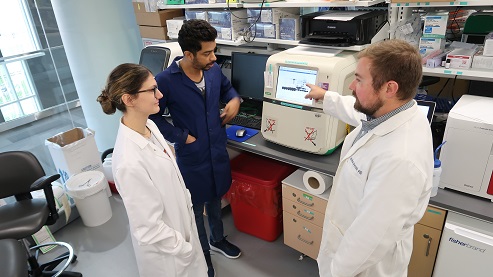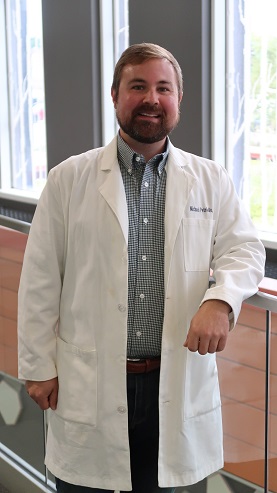
A new grant will help Wayne State University researchers explore the links between bacterial infections, the environmental factors that increase their susceptibility and the risk of preterm birth.
The five-year, $2,858,821 grant from the National Institute of Environmental Health Sciences of the National Institutes of Health for “PFAS increases susceptibility to infection-mediated preterm birth” will be led by Michael Petriello, Ph.D., assistant professor in Wayne State’s Institute of Environmental Health Sciences and the Department of Pharmacology in the School of Medicine.
Dr. Petriello hopes that the team’s studies will identify critical pathways responsible for preterm birth and establish a causative link between pollutant exposures and adverse birth outcomes. He said Wayne State’s collaborative atmosphere made the study possible.

“When I came to Wayne State five years ago, I was looking for interdisciplinary collaborators and I saw how strong this university is in terms of preterm birth studies and expertise,” Dr. Petriello said. “Dr. Gil Mor has done some great work on the subject, and he was focusing mainly on viruses. We’ve initiated the collaboration with the C.S. Mott Center for Human Growth and Development thanks to studies by our Superfund Research Center, the Center for Leadership in Environmental Awareness and Research, related to benzine exposure in preterm births. Now we’re all pooling our expertise to explore new avenues on this subject.”
Dr. Petriello and his collaborators hypothesize that pollutant exposures, particularly per- and poly fluoroalkyl substances, or PFAS, can increase the susceptibility to bacterial infection and increase preterm birth risk, resulting in children being born too early and potentially leading to severe health issues or even death.
“We hope to find links between PFAS exposure in mothers and preterm birth, focusing on the placenta as a major target of PFAS toxicity,” he said. “We think it is an under-studied organ in terms of PFAS exposure. What we are doing that is novel is using spatial transcriptomics, which looks at different regions of the placenta to see which cell types are affected by the PFAS. We also want to look at bacterial infection as a factor in preterm birth to see if PFAS exposure increases that likelihood of infection.”
This complex research requires an interdisciplinary team including additional faculty at Wayne State with expertise in maternal and fetal health (Dr. Mor), genomics (Drs. Doug Ruden and Katherine Gurdziel) and chemistry (Dr. Charlie Fehl).
“In order to solve many of the problems in our community, such as preterm birth, we need more of this type of collaborative work between experts in different fields,” said Dr. Mor, M.D., the scientific director of the C.S. Mott Center for Human Growth and Development. “Dr. Petriello is an outstanding environmental science scientist. My interest has been how the placenta responds to infections, but it has always been a challenge to us that some women would respond to changes in the environment and others don’t. Some had major complications during COVID, and others weren’t affected at all, for instance. We are creating animal models to study these environmental effects on pregnancy. I originally came to Detroit because it is the capital in the United States, unfortunately, for preterm birth, and there was strong chance that this high rate was because of environmental factors.”
“The link between a community’s environment and its health is crucial,” said Ezemenari Obasi, Ph.D., vice president for Research & Innovation at Wayne State University. “This important study led by Dr. Petriello will provide new knowledge on this topic and offer new ideas to improve people’s lives.”
The award number for this grant from the National Institute of Environmental Health Sciences of the National Institutes of Health is ES035692.